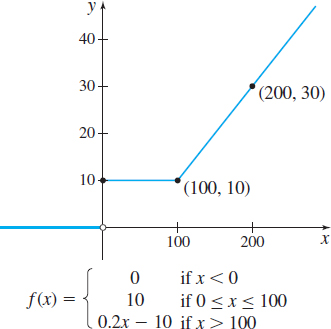EXAMPLE 5Analyzing a Piecewise-Defined Function
The function f is defined as f(x)={0if x<010if 0≤x≤1000.2x−10if x>100
- (a) Evaluate f(−1), f(100), and f(200).
- (b) Graph f.
- (c) Find the domain, range, and the x- and y-intercepts of f.
Solution (a) f(−1)=0; f(100)=10; f(200)=0.2(200)−10=30
(b) The graph of f consists of three pieces corresponding to each equation in the definition. The graph is the horizontal line y=0 on the interval (−∞,0), the horizontal line y=10 on the interval [0,100], and the line y=0.2x−10 on the interval (100,∞), as shown in Figure 11.
(c) f is a piecewise-defined function. Look at the values that x can take on: x<0, 0≤x≤100, x>100. We conclude the domain of f is all real numbers. The range of f is the number 0 and all real numbers greater than or equal to 10. The x-intercepts are all the numbers in the interval (−∞,0); the y-intercept is 10.
